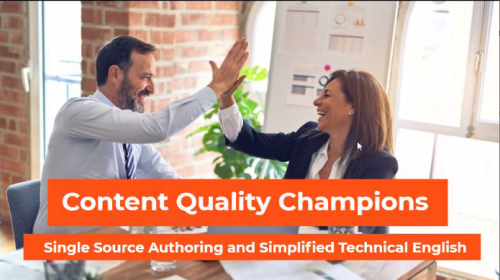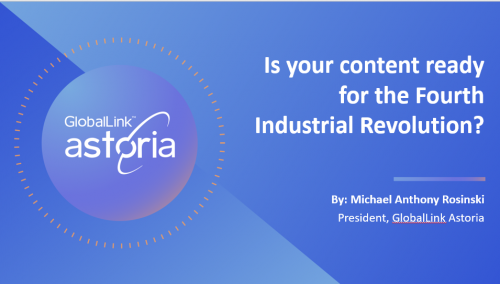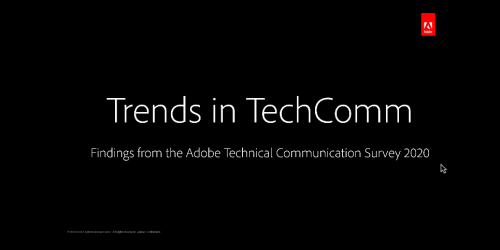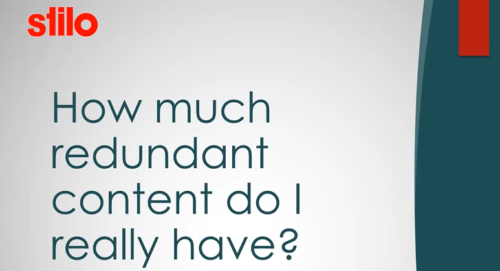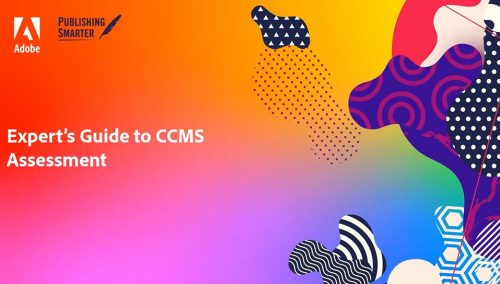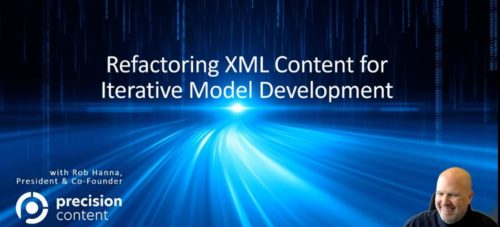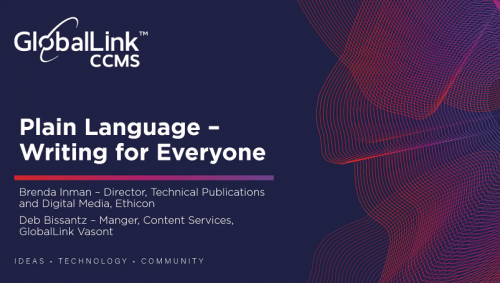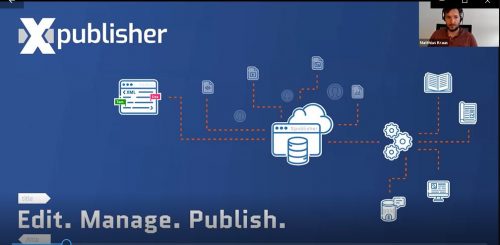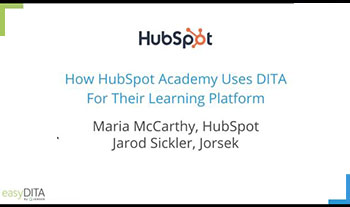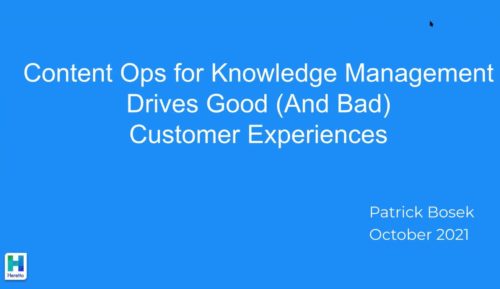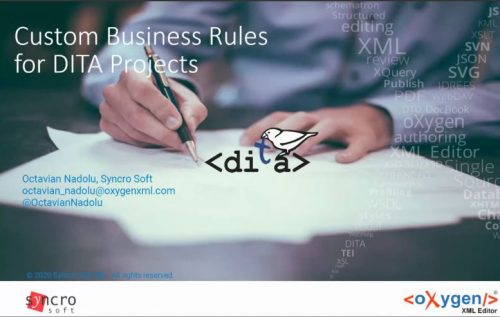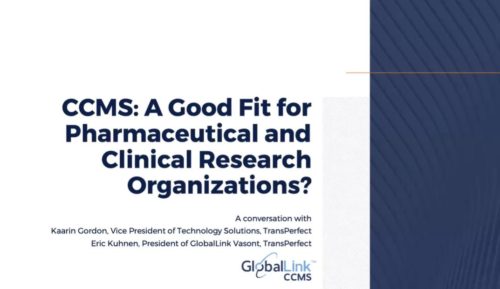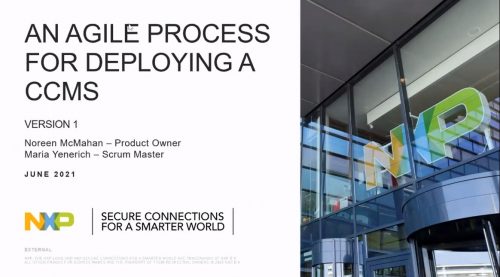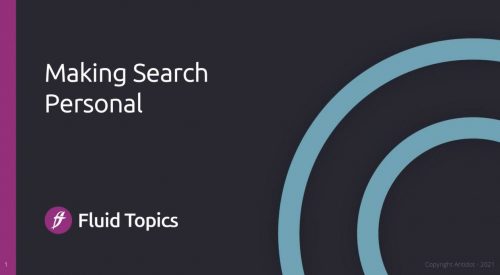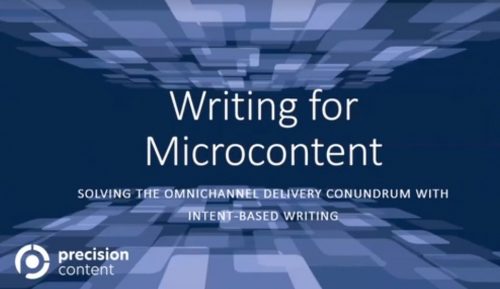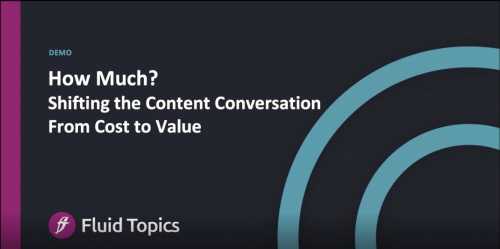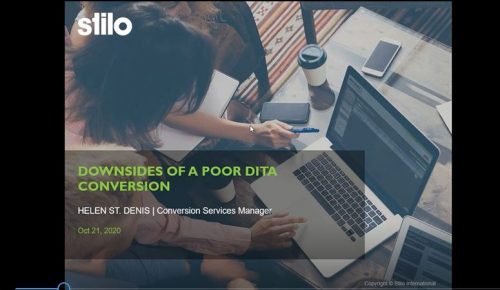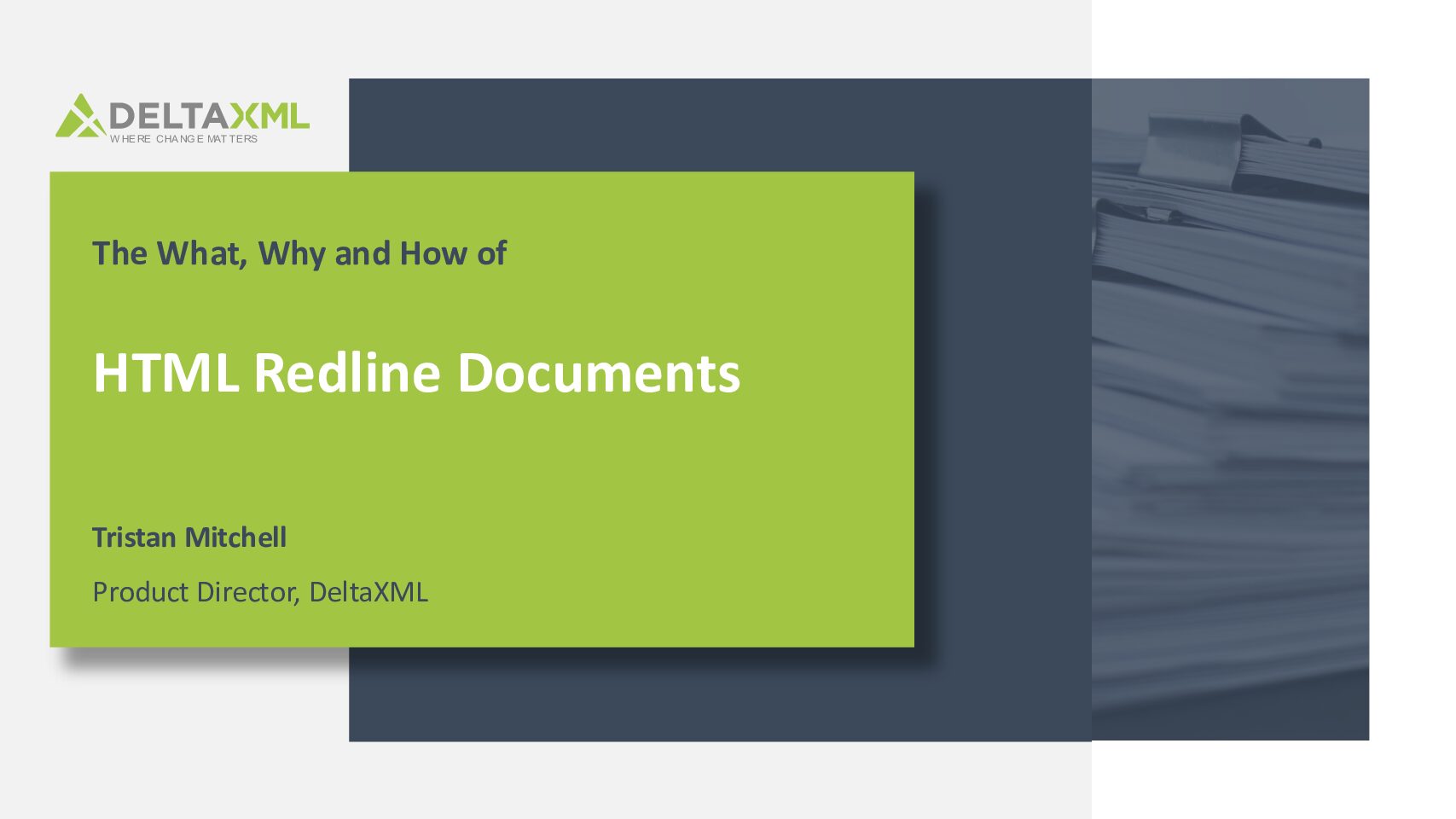- The value of combining an XML CCMS with a Grammarly-like content checker
- A live demo of easyDITA with HyperSTE that shows how the tools work together to help content creators
- A general project plan to help you get started in achieving great results
- An example of a customer implementation and their results
-
March 31, 2021 How do you ensure that your content is consistent and follows your brand’s guidelines? How do you begin a project that’s consistent across your technical communications? Is it an achievable goal? What results should I expect? In this webinar, learn how the combination of easyDITA's CCMS and HyperSTE allows you to check your content against your specific style guide, as well as industry standard grammar and terminology rules. The result is not only scalable and single-sourced content, but clear and concise content across the board. Content that's more cost effective, brand aligned, and ready to attract new customers. Attendees will learn:
-
July 15, 2020 The Fourth Industrial Revolution, sometimes described as the perfect storm of new technologies combined with the asteroid of digital information, has forced companies to adopt new organizational structures to create and distribute content. This presentation will define the new exponential organizations, companies that grow often at 10 times faster than comparable companies, and are guided by a massive transformational purpose to deliver Information Enablement through innovations such as “Content as A Service” – CAAS. Presented by: Michael Rosinski has lead a successful career as a technology executive in the enterprise software industry. Presently, Michael is President of Astoria Software which is the premier CCMS – Component Content Management System in the Technical Product Documentation Vertical. At Astoria, he was first to market to launch the Enterprise SaaS Model and Mobility Platforms. Michael merged the Goldman Sachs venture to TransPerfect, the largest private translation company in the world. Prior to Astoria, Michael was a founding member of American Software’s management team, grew revenues to $ 100M+ and made it to the Forbes Best 200 Small Companies in America list. At American, Michael completed one of the first IPO’s in the ERP market, and later contributed to the successful spin off IPO of Logility in the Supply Chain Management Space. Michael leveraged his international experience as President of Augeo Software, a French/Dutch company in the PSA Professional Automation Space where Computerworld designated them as one of “The Top 100 Companies to Watch” Michael also held Management positions at Johnson & Johnson and Nestle.. Michael holds a Bachelors Degree in Management and Organizational Behavior at Rider University, and has completed MBA study at Fairleigh Dickinson University.
-
April 8, 2020 Technical Communication is in constant change: Requirements and expectations from both authors and consumers of technical content have changed dramatically over the last decade. The rise in digital experience innovation creates new customer expectations and demands. And enterprises around the world are exploring new ways to create new Content Interaction Experiences for their customers. In this presentation, Stefan Gentz will give insights from the Adobe Technical Communication Worldwide Survey 2019/2020. TechComm professionals from 60 countries participated in the survey. He will discuss the driving factors for enterprises around the world when it comes to technical communication. Why do companies choose to work with structured content, and why do they go for a CCMS? How do they deliver their content today – and how will they provide content tomorrow? KEY TAKEAWAYS
- Understand the key factors that are driving companies to move to structured content
- Understand which technologies companies use to author and deliver content today
- Know which are the “hottest” content delivery channels in the future to provide technical content to customers
-
April 6, 2022 Content reuse is one of the many advantages of moving to DITA and a structured standard. It helps us reduce the amount of overall content we have, improve consistency, and decrease redundancy. However, it is difficult to visualize this value before the conversion takes place. Estimates can be off, and it is hardly ever clear how much content we can actually reuse from our documentation. Typos and partial matches only complicate our futile estimates. Narrowing the scope of this approximation by investigating similar matches in our source content before conversion can provide valuable insight to the potential benefits of moving to a structured standard. Join TJ Dhaliwal in this session as he uses Stilo’s Analyzer and Migrate to investigate source content for similar and exact matches. Then, further use that information to plan for conrefs, keyrefs, and topicrefs before any transformation takes place. Conclude by deduplicating exact topic matches and realizing some of the potential that was uncovered in the beginning. Presented by: TJ Dhaliwal is a Technical Sales Product Specialist at Stilo, helping customers uncover solutions to their content conversion needs. With a strong technical background in engineering combined with a passion for public speaking, he’s been able to successfully bridge the gaps between project stakeholders. As a problem solver, TJ has helped several enterprise-level companies convert tens of thousands of pages of their content to DITA. He’s recently taken lead on and helped bring to market Stilo’s newest product, Analyzer.
-
March 24, 2021 Every organization has different content management needs. The needs can be pretty broad or hyper-focused. Everybody has different expectations around the user interface, but the underlying requirements are always based on rich capabilities around legacy content ingestion, authoring, metadata management, storage, delivery, and more. Developing a content strategy is crucial to the success of your CCMS project. Core components help focus your questions, create detailed use cases, and identify candidate departments and content to help assess a CCMS. When you start a CCMS assessment, you should have a comprehensive set of parameters to guide you. It is very important to make the proper discovery and choose the solution which is the right fit. Otherwise, energy is expended to force-fit a solution which usually leads to frustration and wasted resources. Join Divraj Singh, Sr. Solutions Consultant at Adobe, in a conversation with Bernard Aschwanden, CEO at Publishing Smarter, whose organization has done multiple CCMS migrations, to understand the following parameters which will make a CCMS evaluation process easy. They will be leveraging Adobe’s CCMS solution –XML Documentation for Adobe Experience Manager, to showcase some of these workflows.
- What difference does authoring standard make (unstructured, XML, DITA, HTML etc.)?
- How advanced are the content management capabilities (web vs offline, metadata support, advanced search)?
- How does the solution provision for storage (versioning, DAM capabilities etc.)?
- What OOTB workflows does the solution support (review, translation, task management, content ingestion, etc.)?
- What reporting capabilities does it have?
- What publishing capabilities does it provide(DITA OT, integrated tools, third-party plug-ins)?
- How extensible is the solution (APIs, DITA specializations, integration with external systems)?
Bernard Aschwanden is the Founder of Publishing Smarter. Bernard Aschwanden and his company Publishing Smarter help clients reduce costs and improve the quality of content. A past President of the Society for Technical Communications, he trains, writes, and presents on communications, publishing, and single-source reuse. Publishing Smarter helps companies automate content processes to publish better, faster, and smarter and provide a maximum return on investments. Bernard on LinkedIn: https://www.linkedin.com/in/bernardaschwanden/ Bernard on Twitter: https://twitter.com/aschwanden4stc https://twitter.com/publishsmarter Website -
December 1, 2021 Developing robust content models can never be a once-and-done endeavor where IAs are required to incorporate all aspects into the design prior to authoring. Instead, an iterative approach is needed to allow for incremental improvements not just during setup but long into production. Join Precision Content’s President and Chief Information Architect, Rob Hanna, to explore methods the company uses to refine models and update the content corpus through scheduled refactoring activities. Presented by: Rob Hanna is an award-winning technical writer and content strategist and an industry leading expert in structured XML authoring, DITA, and content management. In 2014, Rob was awarded the rank of Fellow of the Society for Technical Communication (STC) and earned the Enterprise Content Management Specialist (ECMs) designation from AIIM. In 2017, he was named one of the top 25 global leaders in content experience strategy by Mind Touch. He founded Precision Content in 2013 after nearly 20 years in the industry as a technical writer, information architect, knowledge management specialist, and taxonomy expert. In 2018, Precision Content joined Google, Adobe, and Acrolinx on the list of "Top 100 Companies that Matter Most in Digital Content Industry" by EContent Magazine. See http://www.linkedin.com/in/singlesourceror for more information.
-
April 21, 2021 The Plain Writing Act of 2010 requires federal agencies to follow plain language guidelines for government documentation. In addition, Section 508 standards require all information and communications technology to be accessible to disabled users. Besides meeting these requirements, are there other advantages for technical writers who use plain language? Yes, there are! Brenda Inman and Deb Bissantz will explore examples of overly verbose information that can be written using plain language to convey the information more clearly. While exploring these examples, Brenda and Deb will also share benefits, guidelines, and tips for using plain language. What can the audience expect to learn? Attendees will learn to recognize opportunities for using plain language, such as when to use a $0.50 word instead of a $5.00 word. Attendees will also learn tips for writing clear, concise information using plain language. Presented by: Deb Bissantz is a Content Services manager for GlobalLink CCMS. Deb’s mission is to partner with organizations to make the most of their DITA and component content management solutions. Before joining GlobalLink CCMS, Deb worked with and authored DITA content for many years. As a writer and tools administrator, she helped several organizations migrate technical documentation to DITA and to a CCMS. Deb is a voting member of the DITA Technical Committee. Brenda Inman is the Director of Technical Publications for Robotics and Digital Solutions at Ethicon, part of the Johnson & Johnson family of companies. Brenda has worked in the medical device her entire career mostly within technical publications and localization and also has experience in clinical research and regulatory affairs. Brenda’s experience within technical publications and localization includes writing user manual content, implementation of content management systems, and setting up best practices for writing and localization.
-
March 17, 2021 Xeditor is a professional online XML editor based on state-of-the-art web standards. With Xeditor, structured, semantically correct content in XML format can be created intuitively, efficiently and without technical knowledge. By enabling authors to work together on structured content from any location at any time, Xeditor helps companies put efficient workflows in place. This way, companies are able to take advantage of all the benefits of standardized content - such as automated further processing - without the need for costly training for authors. Presented by: Matthias Kraus is the founder and managing director of Xpublisher GmbH. Since 2001, he has been advising numerous leading international companies and organizations from the aerospace, technology, education, publishing, public administration and many other industries in the field of multi-channel publishing and accompanying them on their way to digitization.
-
November 18, 2020 Learn how HubSpot Academy, the world’s leader in providing inbound sales, marketing and customer service education, adopted DITA to help solve their content creation, conversion and output needs. HubSpot’s use case is exciting and unique as it pushes the boundaries of what we typically associate with DITA. Rather than producing typical technical documentation, HubSpot is using DITA to produce:
- Complete lessons, courses, and certifications
- Learning assessments
- Powerpoint outputs
- And localizing that content in five languages
-
January 12, 2022 Moving to structured authoring and implementing a CMS are critical projects that will generate long-term efficiency gains and significant savings. But before you get there, there are great hurdles to overcome. First and foremost, there's winning budget approval from your execs, who will have a singular focus on risk and ROI. Second, you need to maintain a high level of commitment and buy-in from those executives over the years that re-engineering of content production can last. Too many content restructuring projects fail or don’t even start because they cannot demonstrate a quick and tangible return on investment - and this is where Dynamic Content Delivery changes the game. Dynamic Content Delivery provides outstanding content experiences to your users and creates immediate value for your company without requiring a big bang in your writing process. It earns you internal support, money, and time you can leverage to optimize your content restructuring process. In this webinar, you will learn:
- How Dynamic Content Delivery generates value from your existing content, no matter the writing tools and methods you are using now
- How to achieve quick wins and build a fast ROI to gain support from your Execs for your content project
- How to optimize your project to move to structured authoring and make it a success
-
October 6, 2021 Our content shapes experiences and drives behavior. The question then becomes, is your content causing positive or negative experiences and behaviors? In this presentation, we’ll take a critical look at content operations (Content Ops), the processes behind your knowledge, and how they make or break customer experiences. You’ll learn:
- Tactics to turn your haphazard workflow into a repeatable process
- Overlooked signs that your content hinders customer experience
- How to ensure your content capability can scale with your company’s growth
-
February 15, 2022 Just putting your technical documentation on your webpage as a PDF for download will not make you a content hero. PDF is a given – a fundamental requirement. However, both business leaders and end customers expect more than just a documentation portal or a well-designed PDF. They want contextually relevant, personalized, consistent, conversational, and scalable content experiences. But how to deliver on this expectation? In this session, Stefan Gentz, Senior Worldwide Evangelist for Technical Communication at Adobe, will share some insights from the recent Adobe-commissioned Forrester study. Forrester surveyed 450 decision-makers on Content Experience Management to understand how global brands deliver relevant and contextual experiences across touchpoints. He will explore the design of positive customer journeys from marketing to technical support and self-service and back to sales – experiences that provide 360° content experience for your customers and handhold them across their whole content journey. Presented by: Stefan’s mission is to inspire enterprises and technical writers around the world and show how to create compelling technical communication content with the Adobe Technical Communication tools. He is also a certified Quality Management Professional (TÜV), ISO 9001 / EN 15038 auditor, ISO 31000 Risk Management expert, and Six Sigma Champion. As a sought-after keynote speaker and moderator at conferences around the world, he travels around the globe half of the year. Besides that, he has been the European Ambassador for the Globalization and Localization Association (GALA) for many years, a member of the tekom Conference Advisory Board for several years, and is now a member of the tekom iiRDS working group for Intelligent Information and member of the OASIS DITA Adoption Committee. In 2016, Stefan Gentz was awarded by MindTouch as one of the Top 25 Leading Content Strategist Influencers in the world and as one of the Top 25 Content Experience Influencers in the world in 2017. Stefan Gentz on LinkedIn Stefan Gentz on XING @stefangentz on Twitter www.adobe.com
-
December 16, 2020 A step by step guide to getting started with Schematron and Schematron Quick Fixes. Schematron and Schematron QuickFix (SQF) languages can be used to improve efficiency and quality when editing DITA documents. You can define actions that will add complex structure in your documents, or make modifications in multiple places or actions that will convert a structure into another. These changes are made by keeping the document structure valid and conforming to your project specification and will help the content writer add content more easily and without making mistakes. Join us to see:
- How to create business rules with Schematron
- How Schematron rules are applied
- How to apply specific Schematron rules on all DITA files
- How to develop Schematron Quick Fixes to make it very easy to solve the reported problems
-
December 8, 2021 Kaarin Gordon discusses the choices and challenges for efficient content reuse facing Pharmaceutical and Clinical Research Organizations. What they want is a set of tools and platforms for easy content reuse, automatic propagation of changes from a single source, and content governance. What they have is Microsoft Word; it’s easy to use but limited to cut-n-paste content reuse. What they must deliver is multi-lingual content for a variety of uses – faster, more cost-effectively, and at lower risk. Join Eric Kuhnen in conversation with Kaarin Gordon for an engaging discussion of how component content management systems amplify or ameliorate some of the difficult content complexities that organizations face today. Presented by: As the Vice President of Life Sciences Technology Solutions at TransPerfect, Kaarin Gordon works closely with organizations on solutions to more effectively develop, manage, translate, and deliver multilingual content. She has spent 20+ years working with pharma, CROs, and medical device companies and focused on developing and implementing solutions that address global content challenges and result in decreased cycle time, reduced risk, increased consistency, and lower costs. Kaarin has a BA from the University of Michigan and an MBA from Columbia University. Eric Kuhnen is the President of GlobalLink Vasont, one of TransPerfect’s GlobalLink CCMS solutions. He has more than 30 years of experience in product research, development, and management. Prior to his current role, managed global operations, product management, pre-sales, and marketing for Astoria Software, a division of TransPerfect, Inc. He has also held profit-loss responsibilities with GoRemote and Oracle Corporation. He has a Bachelor of Science degree in Computer Science from Brigham Young University.
-
December 14, 2021 Attend this webinar if you’re looking to:
- Provide your audience with content that is accurate and compliant
- Align your global workforce with One Voice
- Accelerate your time to market thanks to less time for review and editing
- Reduce your source content and translations by 40%
- Show industry credibility by complying with industry standards to help open new markets
-
June 30, 2021 NXP successfully deployed a DITA CCMS in 2016, in a SaaS environment, to manage technical product documentation. A software and system upgrade to Tridion Docs 14 (CCMS) was planned in 2019-20 to take advantage of new capabilities, performance improvements, system and infrastructure updates. Managing a successful CCMS upgrade requires detailed coordination, planning, testing, communication, and execution. From the webinar, you will learn how NXP effectively utilizes SAFe methodologies, together with their CCMS vendor RWS, to manage and execute the upgrade. Noreen and Maria worked together to coordinate activities on an NXP Agile Release Train (ART) as both are SAFe-certified. Noreen heads the RWS core team, which consists of representatives from several NXP business lines. Maria is from IT, working as the upgrade project Scrum Master. Overall, the upgrade was a success, as it was completed on time and within budget. NXP did encounter some unexpected issues that were managed following this process. During this webinar, Noreen and Maria will discuss how the business and IT benefited by utilizing SAFe methodologies to document CCMS configurations, develop and execute test cases for upgrade testing, managed communications with RWS and third-party vendors, communicated benefits to the business users, and moved all users into an upgraded production system with minimal interruptions. Presented by: Maria Yenerich works as a Scrum Master within the NXP Marketing Information Technology (IT) group. With 20+ years of system management experience, Maria has an undergraduate degree from Creighton University and a Master’s of Business Administration from the University of Illinois. Noreen McMahan has a Ph.D. from the University of Texas in Austin. In 2008, Noreen joined a team deploying a new CCMS in a global company. For almost a decade, she trained users of the CCMS around the world. She authored the online training in the DITA environment using the same tools as the writers and engineers she trained. She began her role as NXP RWS Product Owner after working on a team that deployed SDL LiveContent Architect as the new NXP CCMS in 2016. Later, as the 2020 pandemic gained momentum, Noreen worked on an Agile team that successfully completed an RWS upgrade of the CCMS to Tridion 14. She, therefore, has experience in deploying a new CCMS and in upgrading an existing one. Chip Gettinger is VP Global Solutions Consulting at RWS, managing a team that works with customers in maximizing global content with RWS. He has experience working with customers to develop global content strategies, business ROI adoption drivers, change management, and technology adoption for component content management systems. He speaks and blogs about customer successes working closely with industry standards, partners, and customers in technology solutions and deployments.
-
May 26, 2021 What if the search function on your tech doc was providing personalized results and was as good as Google, reading the mind of your users and anticipating their needs? What about a search engine that learns and gets more accurate, more relevant and personal every day. What does it take to get there? It’s mostly about technology, but not only. It also requires information: about your content (metadata) and about your users (profiles). In this Webinar, we will introduce the challenges, review the possible solutions, and discuss what you need to have and do in order to support this shift to a modern user experience. Presented by: Fabrice Lacroix is a serial entrepreneur and a technology pioneer. He has been working for 25 years on the development of innovative solutions around search technology, content enrichment and AI. He is the founder of Fluid Topics, the leading Content Delivery Platform that reinvents how users search, read and interact with technical documentation.
-
June 2, 2021 Various surveys are showing that the majority of the world’s leading companies have accelerated their digital transformation efforts during the pandemic – efforts that are not slowing down. This presentation will discuss the key role content plays in the field of digitalization, and what you should do to future proof your content while elevating your customer experience. Presented by: Berry Braster has been in the technical documentation field for over 18 years and has helped implement content strategies, including the use of DITA and HyperSTE controlled language software. As Technology Director, Berry is involved with connecting technical documentation to IoT, and how to leverage on technologies like Augmented and Virtual Reality.
-
May 19, 2021 Omnichannel experience is setting the bar for customer expectation and it’s putting new and increasingly complex demands on your business to deliver the right information where your customers need it. Writing for the web is not writing for omnichannel. Preparing your content for emerging technologies requires new approaches to content creation and delivery. It requires a microcontent strategy. Robust content management technology is certainly part of the solution, and your organization will be tempted to invest in new tools for chatbots and voice. However, before you go ahead and fill yet another content silo with zettabytes of information, instead make enhancements to the content creation programs you already have. Microcontent is the next evolution in structured authoring and will open new channels for your content while improving delivery across existing channels. In this session, we will focus on the missing link in a successful microcontent strategy: an intent-based writing methodology. We will highlight some key concepts that will help you to start looking at your content through an omnichannel lens. Presented by: Mike Rowlinson is the VP of Training & Content Services at Precision Content. Mike has been working in the technical communications industry since 2005. His core belief is that great content enables great companies. Mike’s division develops and delivers engaging and effective training and transformation engagements including the recent completion of the firm's eLearning product, the 15 modules self-paced, Precision Content® Writer Training. The training enables writers to create effective content so that staff and customers alike can find what they need and understand what's required quickly and efficiently.
-
April 14, 2021 Unsurprisingly, when it comes to the money your company spends producing technical documentation, your management knows the cost down to the penny. And when it comes to investing in THE content delivery solution that will streamline your work process, unleash your content, and transform your user experience, one question will arise without a doubt: “How much?” Meaning: “How much will it cost?" This can be a completely different conversation if you can turn it into “how much it will save” and “how much additional revenue it will bring to the company." In this webinar, we will give you a clear picture of the cost savings and gains a content delivery platform such as Fluid Topics can generate across three areas: customer and partner service, employee productivity, and client satisfaction. We will also give you access to a tool that will help you navigate scenarios and determine how long it will take to achieve a return on your investment by customizing the calculator’s numbers to fit your situation. Presented by: Geraldine Boulez is passionate about new technologies and their ability to solve people and business problems. This is what has led her to product management, marketing and business development positions in fast-growing tech companies and innovative corporations for over twenty years. Geraldine is VP of Marketing at Fluid Topics, the leading Content Delivery Platform that reinvents how users search, read and interact with technical documentation.
-
October 21, 2020 Thinking of automating your entire conversion process to DITA? Wanting to handle conversion work manually, in-house? Before you proceed, think about how the conversion could help you derive the benefits of DITA that you expect. A simplistic approach may allow you to publish something that looks just like what you have now. But a really good quality conversion will help you to leverage content reuse, personalization and multi-channel publishing, as well as making it easier to maintain and update your content. For example, will your conversion generate keys and keyrefs for variables? How about a relationship table, to prevent broken links? Will menu cascades be correctly marked up, for localization purposes? Presented by: Helen joined Stilo as a technical editor. She now works closely with Stilo Migrate customers, helping them to analyze their legacy content and configure appropriate mapping rules. She also provides Migrate customer training and support. Helen has helped Migrate customers to convert tens of thousands of pages of content to DITA and custom XML. Helen holds a Bachelor of Arts in English from St. Francis Xavier University in Antigonish, Nova Scotia, and has pursued graduate studies at Queen’s University in Kingston, Ontario.
-
Recorded on October 16, 2024
 HTML is used not only as a final delivery format but increasingly as the source format for documentation of all kinds, whether that’s internal product designs or customer-focused technical documentation. Understanding change in those documents is a vital part of your content management workflow.
Join us as we explore the ins and outs of HTML redline documents, looking at how to identify change in HTML, how to visualise it, and how it fits into your toolkit. From text to tables, MathML to SVG, come and discover how to decide what matters in your redline output.
Presented by: Tristan Mitchell, DeltaXML
HTML is used not only as a final delivery format but increasingly as the source format for documentation of all kinds, whether that’s internal product designs or customer-focused technical documentation. Understanding change in those documents is a vital part of your content management workflow.
Join us as we explore the ins and outs of HTML redline documents, looking at how to identify change in HTML, how to visualise it, and how it fits into your toolkit. From text to tables, MathML to SVG, come and discover how to decide what matters in your redline output.
Presented by: Tristan Mitchell, DeltaXML
 Tristan is Product Director at DeltaXML, a technology company with world-leading software products for managing change in structured content. He has a deep understanding of DeltaXML’s product suite and loves to help customers create extra value in their content using change management. Tristan is a father to three daughters, a movie lover, and a keen runner.
Tristan is Product Director at DeltaXML, a technology company with world-leading software products for managing change in structured content. He has a deep understanding of DeltaXML’s product suite and loves to help customers create extra value in their content using change management. Tristan is a father to three daughters, a movie lover, and a keen runner.
-
Recorded on: November 14, 2024
 Presented by: Toni Ressaire, Technically Write IT (TWi); Rahel Bailie, Technically Write IT (TWi); and Fraser Doig, RWS
Presented by: Toni Ressaire, Technically Write IT (TWi); Rahel Bailie, Technically Write IT (TWi); and Fraser Doig, RWSAre you struggling to articulate the value of structured content to your management? Discover how the challenge of AI readiness can become your greatest opportunity.
In this webinar, we'll explore how the tightening AI regulations can transform structured content into the Swiss army knife of your organization. By adopting structured content, you're not just preparing for AI – you're solving multiple challenges with a single strategy.
Learn how structured content can help you:
- Achieve AI readiness
- Improve accessibility
- Comply with upcoming legislation
- Deliver personalized user experiences
- Scale content operations across products, languages, and markets while containing your budget
For content professionals and decision-makers alike, this webinar provides a compelling case for structured content as the cornerstone of AI readiness and beyond. You'll gain valuable insights on how to communicate this multifaceted value proposition to your management, turning potential regulatory hurdles into a catalyst for organizational improvement.
Join us to discover why structured content isn't just about AI readiness – it's the key to solving numerous content challenges while future-proofing your organization.

Toni Byrd Ressaire, MSc Technical Communications, is the Director of Innovation at Technically Write IT. She helps to drive strategy and innovative solutions for TWi clients. TWi is an Ireland-based consultancy of content specialists who provide content strategy, content operations, language, learning, user adoption, and content production services. TWi works with companies wanting to solve their content problems for business impact.
 Rahel Anne Bailie, FSTC, FISTC, is the Content Solutions Director at Technically Write IT. She brings a wealth of experience to helping companies get more value from their content assets. TWi is an Ireland-based consultancy of content specialists who provide content strategy, content operations, language, learning, user adoption, and content production services. TWi works with companies wanting to solve their content problems for business impact.
Rahel Anne Bailie, FSTC, FISTC, is the Content Solutions Director at Technically Write IT. She brings a wealth of experience to helping companies get more value from their content assets. TWi is an Ireland-based consultancy of content specialists who provide content strategy, content operations, language, learning, user adoption, and content production services. TWi works with companies wanting to solve their content problems for business impact.
 Fraser Doig is a Senior Associate Product Marketing Manager specializing in helping companies of all industries understand how structured content can elevate their business. At RWS, Fraser works in the Language and Content Technology division, always on the lookout for the latest and greatest developments in the market. He is a regular contributor to publications such as KMWorld and Customer Service Manager Magazine.
Fraser Doig is a Senior Associate Product Marketing Manager specializing in helping companies of all industries understand how structured content can elevate their business. At RWS, Fraser works in the Language and Content Technology division, always on the lookout for the latest and greatest developments in the market. He is a regular contributor to publications such as KMWorld and Customer Service Manager Magazine.
-
Recorded on August 28, 2024
 Join us for a fireside chat featuring industry leader, Laura Bellamy and Acrolinx VP of Strategy, Paul Bongers. During this webinar, Paul and Laura will discuss a data-driven content approach to ensure great customer experiences, including:Presented by: Paul Bongers, Acrolinx and Laura Bellamy
Join us for a fireside chat featuring industry leader, Laura Bellamy and Acrolinx VP of Strategy, Paul Bongers. During this webinar, Paul and Laura will discuss a data-driven content approach to ensure great customer experiences, including:Presented by: Paul Bongers, Acrolinx and Laura Bellamy- How a data-driven approach supports content quality initiatives in the enterprise.
- How AI is changing the way organizations look at content quality.
- The impact of AI in the content supply chain.
 Paul Bongers, VP StrategyPaul shapes the Acrolinx product strategy. He's worn many hats in SaaS businesses, but at heart he's a strategist and a technologist. Paul brings a wealth of experience and creativity to Acrolinx. His work with partner ecosystem development, SaaS strategy development along with a deep passion for user-centric technology set the tone of innovation at Acrolinx.
Paul Bongers, VP StrategyPaul shapes the Acrolinx product strategy. He's worn many hats in SaaS businesses, but at heart he's a strategist and a technologist. Paul brings a wealth of experience and creativity to Acrolinx. His work with partner ecosystem development, SaaS strategy development along with a deep passion for user-centric technology set the tone of innovation at Acrolinx. Laura Bellamy, Director of Content Insights and Quality
[email protected]
Laura has 20+ years of experience in the content and customer experience industry where she brings a forward-thinking mindset to help teams adapt and grow. She has been recognized for award-winning user-centered experiences and innovations. Formerly at AWS, she led the Content Insights & Quality to establish evidence-based standards for content quality and performance. Prior to Amazon, she led Content Strategy and Information Experience for VMware and served as an information architect for IBM. She is a co-author of the book DITA Best Practices: A Roadmap for Writing, Editing, and Architecting in DITA.
Laura Bellamy, Director of Content Insights and Quality
[email protected]
Laura has 20+ years of experience in the content and customer experience industry where she brings a forward-thinking mindset to help teams adapt and grow. She has been recognized for award-winning user-centered experiences and innovations. Formerly at AWS, she led the Content Insights & Quality to establish evidence-based standards for content quality and performance. Prior to Amazon, she led Content Strategy and Information Experience for VMware and served as an information architect for IBM. She is a co-author of the book DITA Best Practices: A Roadmap for Writing, Editing, and Architecting in DITA.

